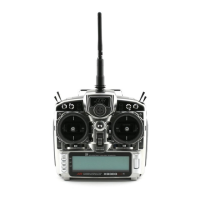
Do you have a question about the JR X9303 2.4 and is the answer not in the manual?
| Frequency | 2.4GHz |
|---|---|
| Modulation | DSM2/DSMX |
| Channels | 9 |
| Telemetry | No |
| Display | LCD |
| Frame Rate | 22ms |
| Model Memory | 30 |
| Model Type | Airplane, Helicopter |
| Modes | Mode 1, Mode 2 |
| Battery Type | 9.6V NiMH |
Explains how to use the manual and lists transmitter features.
Details specifications for the JR X9303 transmitter.
Comprehensive specifications and features of the X9303 2.4 transmitter.
Specifications and features of the JR R921 receiver.
Technical specifications for servos, charger, and battery pack.
Instructions and precautions for charging transmitter and receiver batteries.
Identifies front panel controls and features of the X9303 2.4 transmitter.
Details control stick tension, advanced trims, stick length, and neckstrap attachment.
Guidance on installing the JR R921 receiver and important installation tips.
Explains ModelMatch technology and the binding procedure.
Details SmartSafe and Preset Fail-Safe systems and their programming.
Procedures for standard and advanced range checks on the system.
Information on using the Flight Log and tips for operating 2.4GHz systems.
Guidelines for ensuring adequate power for the receiver.
Lists advanced features available in the ACRO mode for fixed-wing aircraft.
Basic steps for programming a new aircraft model in ACRO mode.
Explains the powerful Device SEL and Wing Type functions for advanced features.
How to activate and configure flight modes for specific maneuvers.
Settings for common trim and dual rate behavior with flight modes.
Adjusting servo direction and fine-tuning servo arm alignment.
Setting servo travel limits and adjusting trim sensitivity.
Configuring dual rates and exponential curves for flight response.
Customizing throttle curves, flap deployment, and elevator compensation.
Configuring elevator-to-flap and aileron-to-rudder mixing for improved maneuvers.
Adjusting aileron differential for roll handling and servo speed.
Configuring snap roll functions and gyro gain sensitivity.
Introduction to standard and multi-point programmable mixers.
Demonstrates programming standard and multi-point mixes for specific aircraft needs.
Procedures for backing up and transferring model configurations.
Explains sub trim for servo alignment and mechanical advantage principles.
Detailed explanation of dual rates and exponential for flight control tuning.
Lists advanced features for helicopter models including swashplate mixing.
Basic steps for programming a new helicopter model in HELI mode.
Explains Device SEL for flight modes and Swash Type for control systems.
How to activate additional flight modes (3 and 4) for helicopters.
Configuring dual rates and exponential curves for helicopter flight response.
Adjusting servo direction of travel for proper control surface movement.
Minor adjustments to servo linkages for precise centering.
Setting up swashplate mixing for various CCPM configurations.
Smoothing swashplate movement using exponential curves.
Configuring throttle hold for autorotation and automatic throttle cutoff.
Mixing tail rotor with throttle/pitch to counteract torque.
Adjusting gyro gain sensitivity for stable helicopter flight.
Introduction to standard and multi-point programmable mixers for helicopters.
Selecting and copying model memories within the transmitter.
Procedures for transferring models and resetting model data.
Adjusting trim sensitivity for helicopter control surfaces.
Lists features for sailplanes including flight modes and mixing.
Specifies servo connection locations in the receiver for sailplanes.
Adjusting trim sensitivity and selecting device functions for sailplanes.
Configuring wing types and selecting flight modes for sailplanes.
Setting up elevator-to-flap and aileron-to-flap mixing for sailplanes.
Adjusting aileron/flap differential, camber, and butterfly (landing flaps).
Configuring flap rates, motor hold, and programmable mixes for sailplanes.
Important precautions for servo installation and general notes on model flying.
Essential safety guidelines and practices for pilots.
FCC compliance information and pre-flight inspection checklist.
Details the three-year limited warranty and its exclusions.
Information on obtaining support, service, and repair procedures.